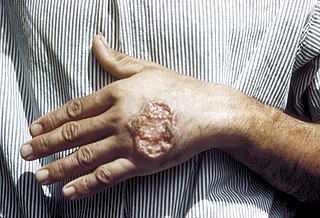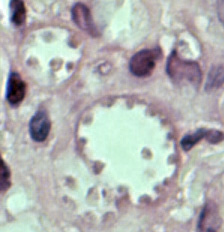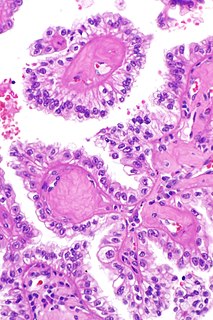Related Research Articles

Skin cancers are cancers that arise from the skin. They are due to the development of abnormal cells that have the ability to invade or spread to other parts of the body. There are three main types of skin cancers: basal-cell skin cancer (BCC), squamous-cell skin cancer (SCC) and melanoma. The first two, along with a number of less common skin cancers, are known as nonmelanoma skin cancer (NMSC). Basal-cell cancer grows slowly and can damage the tissue around it but is unlikely to spread to distant areas or result in death. It often appears as a painless raised area of skin that may be shiny with small blood vessels running over it or may present as a raised area with an ulcer. Squamous-cell skin cancer is more likely to spread. It usually presents as a hard lump with a scaly top but may also form an ulcer. Melanomas are the most aggressive. Signs include a mole that has changed in size, shape, color, has irregular edges, has more than one color, is itchy or bleeds.

Leishmaniasis is a disease caused by parasites of the Leishmania type. It is spread by the bite of certain types of sandflies. The disease can present in three main ways: cutaneous, mucocutaneous, or visceral. The cutaneous form presents with skin ulcers, while the mucocutaneous form presents with ulcers of the skin, mouth, and nose, and the visceral form starts with skin ulcers and then later presents with fever, low red blood cells, and enlarged spleen and liver.

Squamous-cell skin cancer, also known as cutaneous squamous-cell carcinoma (cSCC), is one of the main types of skin cancer along with basal cell cancer, and melanoma. It usually presents as a hard lump with a scaly top but can also form an ulcer. Onset is often over months. Squamous-cell skin cancer is more likely to spread to distant areas than basal cell cancer. When confined to the outermost layer of the skin, a precancerous or in situ form of cSCC is known as Bowen's disease.

Melanoma, also known as malignant melanoma, is a type of skin cancer that develops from the pigment-producing cells known as melanocytes. Melanomas typically occur in the skin but may rarely occur in the mouth, intestines or eye. In women, they most commonly occur on the legs, while in men they most commonly occur on the back. About 25% of melanomas develop from moles. Changes in a mole that can indicate melanoma include an increase in size, irregular edges, change in color, itchiness or skin breakdown.

Pressure ulcers, also known as pressure sores or bed sores, are localised damage to the skin and/or underlying tissue that usually occur over a bony prominence as a result of usually long-term pressure, or pressure in combination with shear or friction. The most common sites are the skin overlying the sacrum, coccyx, heels, and hips, though other sites can be affected, such as the elbows, knees, ankles, back of shoulders, or the back of the cranium.

An eschar is a slough or piece of dead tissue that is cast off from the surface of the skin, particularly after a burn injury, but also seen in gangrene, ulcer, fungal infections, necrotizing spider bite wounds, tick bites associated with spotted fevers, and exposure to cutaneous anthrax. The term "eschar" is not interchangeable with "scab". An eschar contains necrotic tissue, whereas a scab is composed of dried blood and exudate.
Indigestion, also known as dyspepsia or upset stomach, is a condition of impaired digestion. Symptoms may include upper abdominal fullness, heartburn, nausea, belching, or upper abdominal pain. People may also experience feeling full earlier than expected when eating.

Sucralfate, sold under various brand names, is a medication used to treat stomach ulcers, gastroesophageal reflux disease (GERD), radiation proctitis, and stomach inflammation and to prevent stress ulcers. Its usefulness in people infected by H. pylori is limited. It is used by mouth(for upper GIT ulcers) and rectally(for radiation proctitis).

Venous ulcers are wounds that are thought to occur due to improper functioning of venous valves, usually of the legs. They are the major occurrence of chronic wounds, occurring in 70% to 90% of leg ulcer cases. Venous ulcers develop mostly along the medial distal leg, and can be painful with negative effects on quality of life.

Marjolin's ulcer refers to an aggressive ulcerating squamous cell carcinoma presenting in an area of previously traumatized, chronically inflamed, or scarred skin. They are commonly present in the context of chronic wounds including burn injuries, varicose veins, venous ulcers, ulcers from osteomyelitis, and post radiotherapy scars.

Levamisole, sold under the brand name Ergamisol among others, is a medication used to treat parasitic worm infections. Specifically it is used for ascariasis and hookworm infections. It is taken by mouth.

A kanger is an earthen pot woven around with wicker filled with hot embers used by Kashmiris beneath their traditional clothing to keep the chill at bay, which is also regarded as a work of art. It is normally kept inside the Phiran, the Kashmiri cloak, or inside a blanket. If a person is wearing a jacket, it may be used as a hand warmer. It is about 6 inches (150 mm) in diameter and reaches a temperature of about 150 °F (66 °C). It comes in different variants, small ones for children and large ones for adults.

Leishmania mexicana belongs to the Leishmania genus and is the causal agent of cutaneous leishmaniasis in Mexico and central America.
Peat fire cancer is a cutaneous condition that may develop on the shins of women due to hydrocarbon-fueled heat exposure from coal-fired clothing warmers.
Kairo cancer is a cutaneous condition that may develop due to hydrocarbon-fueled heat exposure from coal-fired clothing warmers.
Kang cancer is a form of squamous-celled carcinoma associated with sleeping on the traditional kang heated-brick bed of Tibet and Northern China. The kang bed is a hollow brick platform warmed by an internal coal, charcoal, or dung fire. Kang cancer often develops in previous burn scar tissue, indicating that smoke carcinogens may not play a role.
Kangri cancer is a type of squamous-cell carcinoma of the skin. It is found only in Kashmir in the northwest of the Indian subcontinent. It occurs on the lower abdomen and inner thighs and is due to the use of a kanger, a ceramic pot covered with wicker-work, carried as a source of warmth during cold weather. One of the earliest records of the condition was made in 1881 by surgeons at the Kashmir Mission Hospital and its cause was recognized in the early 20th century by Arthur Neve.

Reed’s syndrome is a rare inherited condition characterised by multiple cutaneous leiomyomas and, in women, uterine leiomyomas. It predisposes for renal cell cancer, an association denominated hereditary leiomyomatosis and renal cell cancer, and it is also associated with increased risk of uterine leiomyosarcoma. The syndrome is caused by a mutation in the fumarate hydratase gene, which leads to an accumulation of fumarate. The inheritance pattern is autosomal dominant.

Sari cancer is a type of skin cancer that occurs along the waistline in females wearing the sari, caused by constant irritation which can result in scaling and changes in pigmentation of the skin. It is a rare type of cancer and generally found in the Indian subcontinent, where saris are commonly worn by girls and women throughout their lives. It is similar to Marjolin's ulcer in cause, involving chronic inflammation.
References
- ↑ Rapini, Ronald P.; Bolognia, Jean L.; Jorizzo, Joseph L. (2007). Dermatology: 2-Volume Set. St. Louis: Mosby. p. 1356. ISBN 978-1-4160-2999-1.
- ↑ MARJOLIN'S ULCER OF THE SCALP: CASE REPORT AND LITERATURE REVIEW. Malheiro E., Pinto A., Choupina M., Barroso L., Reis J., Amarante J. Servigo Cirurgia Plastica, Hosp. S. Joao, Porto, Portugal. Annals of Burns and Fire Disasters - vol. XIV - n. 1 - March 2001. Available at: http://www.medbc.com/annals/review/vol_14/num_1/text/vol14n1p39.htm
| This cutaneous condition article is a stub. You can help Wikipedia by expanding it. |